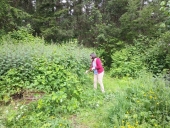








I read this book as an American forager. Our family forages hundreds of pounds of wild foods a year and they make up a big part of our diet. We forage wild asparagus, mushrooms, elderberries, acorns (once processed they make a fantastic flour), ramps, lambs quarters, apples, pears, gooseberries, raspberries, wood sorrel, dandelions and their flowers, nettles and much more. I wouldn't want to live without foraged foods, not just because they're free and incredibly healthy but also because they just taste so much better than most grocery store produce. We also forage for a lot of medicinal plants like plantain, elderberries, mullein, etc.
I was hoping to find a sort of kinship in this book and learn how people on the other side of the world use wild plants in similar and different ways from the ways we do. This book didn't really hit that mark. There's more talk of a few people doing really complicated ways of foraging and processing foods in traditional ways than just modern Japanese people subsisting on the delicious and healthy wild plants that are all around.
At one of our local foraging spots, we frequently run into Hmong families that harvest completely different greens than we do. One morning, my teenage daughter and one such family tried to communicate with each other about what they were each harvesting. For our family, it was spring ramps and nettles (one of the healthiest wild plants in the world, and surprisingly tasty once you blanch them and remove the sting or blend them in smoothies). My husband and daughter didn't recognize the greens they were harvesting but they seemed very enthusiastic about them. I was hoping to learn more about the plants that might be loved in other places and go unappreciated here, or to even learn new ways of enjoying plants that are found in both regions.
This was definitely an interesting book. I was often saddened about how much is being lost in Japan in terms of both nature and traditions (Bird describes massive trees that are being purchased from rural families so companies can use them to make one-slab tables for very rich people from the giant trunks, for instance). It almost seems like a tribute to the past rather than a modern foraging guide for Japan. It is fascinating and well written, but probably not ultimately helpful for those interested in actually foraging either in Japan or elsewhere.
Robert Ray wrote:Trying to stay away from Toxic Gick territory but I imagine most of us here have at least one plastic pot in the mix. I referred to this post about plastic use and was at least somewhat put at ease in the way I use plastic in the garden. Plastic is not a perfect solution but It does have a place in some instances for me.
https://www.gardenmyths.com/growing-food-plastic-containers-safe/